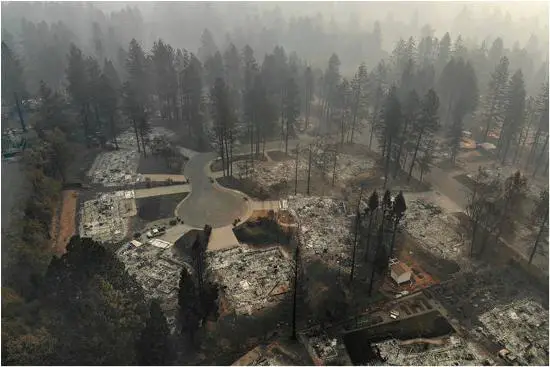Building codes, state grants and low insurance rates have encouraged people to flee expensive cities for their dangerously fire-prone fringes.

A Nov. 15 view in Paradise, Calif., above, shows charred remains of houses among the trees after the Camp Fire burned down more than 11,000 homes. PHOTO: CAROLYN COLE/LOS ANGELES TIMES/GETTY IMAGES
The historically deadly wildfires that have roared through California this fall, and a string of similarly destructive ones over the past two years, are boosting calls to do more to slow climate change. But another underlying problem has contributed to the fires’ tragic damage: For decades, California, supposedly the greenest of states, has artificially lowered the cost of encroaching on nature by living in the woods.
Permissive building codes, low insurance rates and soaring taxpayer spending on firefighting and other services have provided an economic framework that has encouraged people to flee the state’s increasingly expensive cities for their leafy fringes. The forested exurbs, including places once thought too hilly or too dry to develop safely, have offered comparatively affordable living with jaw-dropping views.
The upshot: More houses have been packed into the fire-prone border between civilization and forest—known among planners as the “wildland-urban interface,” or WUI—in California than in any other state.
This problem isn’t restricted to California’s woodland. Along the coasts, loose building standards and easy federal flood insurance have socialized the costs of building in the path of worsening storms and rising sea levels. It is time, in the parlance of classical economics, to internalize the long-externalized costs of building in the trees or by the beach.
California, both a bellwether of aggressive environmental policy and a pioneer of suburban sprawl, typifies the problem. For years, Cal Fire, the state wildfire-fighting agency, has been spending increasing sums to put out wildfires, as has the U.S. Forest Service. Already by 2006, according to an audit, most of the money the forest service was spending to put out large fires was “directly linked to protecting private property” in the wildland-urban interface. Meanwhile, at public cost, government has been encouraging more development by pushing infrastructure—roads, utilities, rescue services—ever farther into the forest.
Lax building codes are at the base of the problem. Even in California, which has some of the toughest such rules in the country, they often aren’t adequate or adequately enforced. The codes often dictate the use of fire-retardant materials in house construction but typically say nothing about how a development must be situated on the landscape—and that can help determine whether that development will burn in a fire, says Max Moritz, a cooperative-extension wildfire specialist at the University of California, Santa Barbara. “So the developers are able to come in, propose something, and often, without too much oversight, walk away after having built something in a dangerous place,” he says. “And we pick up the tab.”
In Redding, a city in far northern California where some neighborhoods were devastated by this summer’s massive Carr Fire, city officials have worked in the past with developers navigating the building code to help them save on costs, City Manager Barry Tippin says. For instance, Redding let a developer build a subdivision with just one road in and out instead of two under an allowed exception in the code; the one road was wider, but two are generally considered safer in an emergency. Now, he says, officials are reassessing their view of the code and have won a grant to pay for an outside review of their rules. “In the future, we should take a more deliberate and maybe harder stance,” he says.
Between 2000 and 2013, more than three-quarters of all buildings destroyed by fire in California were in the state’s WUI, and more were destroyed there than in all the WUI areas across the rest of the continental U.S. combined, according to a recent study led by Anu Kramer, a researcher at the University of Wisconsin-Madison. That is partly because of increasing construction in the WUI and partly because it is so weakly regulated. Ray Rasker, executive director of Headwaters Economics, a Montana-based nonprofit research firm that specializes in wildfires, notes that rules to protect buildings from fire—for instance, requirements for sprinklers and for regular fire-code inspections—tend nationally to be far stricter in urban areas than in the WUI, despite the relative risk. “If you place a home out in the woods, in a tinderbox, those rules don’t apply,” he says. “It’s backward.”
Once a house is built in California’s WUI, the state’s unusually low insurance rates have the effect of shifting much of the real cost. The average California homeowner pays about $1,000 a year in homeowner’s insurance—about half the level in Florida or Texas, two other states with markedly rising incidences of natural disasters believed linked to climate change.
That is a result of state policy, not an accident. California has an elected state insurance commissioner, one of 11 in the country who are elected, who caps the rates private insurance companies may charge. When insurers seek permission to raise rates to cover catastrophes, state law requires that they average at least 20 years of prior catastrophic-loss data, which minimizes the recent dramatic increases in fire damage. Those increases, wildlife specialists warn, suggest things to come.

